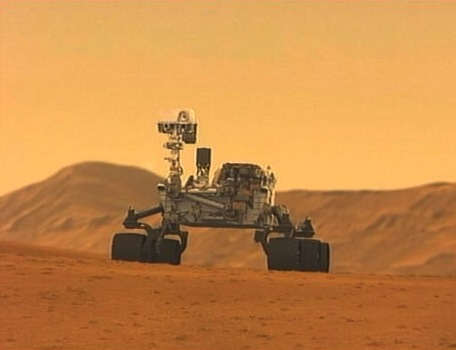Even those familiar with past triumphs of the U.S. space program had to take notice Sunday when Curiosity, NASA's Mars Science Laboratory rover, landed safely on Mars, and then again on Tuesday, when the first color photos of the Martian landscape were transmitted to Earth. The start of the rover's multi-year voyage of discovery on our nearest planetary neighbor is the beginning of a remarkable mission that reaffirms the United States' leadership in space exploration.
The so-far flawless mission might lead some to believe that a landing on Mars is now routine. Not so. Some NASA craft have landed safely and been deployed on the planet, but others were lost. Not Curiosity. The lab, which weighs about a ton and is the size of a compact car, achieved a perfect landing after an eight-month, 352-million mile trip through space. It and arrived on target after a harrowing descent that in itself is a major engineering triumph.
Because the Martian atmosphere provides little friction to slow a falling object, Curiosity had to slow from 13,000 miles per hour to zero in seven minutes. A well-designed system that employed a heat shield, parachute, rockets and cables slowed the craft to 2 miles per hour and allowed it to plop gently on the rocky landscape of a crater. The landing understandably prompted huge celebrations at NASA.
There's much to celebrate. The success shows that American ingenuity and science, often maligned lately, remain formidable. So do U.S. industry and craftsmen. The rover -- indeed, the entire mission -- can be stamped "Made in the U.S.A." Companies from 33 states contributed to the mission. Litespeed Bicycle employees in Ooltewah, for example, used their expertise in crafting titanium to manufacture the rover's arms. Workers there -- and in other U.S. plants -- can say with truth and pride that their work has a real role in the exploration of Mars.
The mission is an ambitious and, at $2.5 billion, an expensive expedition. Nevertheless it is worth the cost and effort. Scientists expect that the array of equipment aboard Curiosity will provide new insight into the planet's past and present. The extended mission surely will expand mankind's knowledge of the planet and will help create the eventual blueprint for manned exploration of Mars. The complex mission also fires the imagination and stirs the intellect.
The initial success of Curiosity seems to have enveloped even those most familiar with the mission in a sense of wonder. "It's just mind-boggling to me," said the chief engineer for the landing team. "This really is a human endeavor ... God bless America, because we did put something on Mars," added an engineer at NASA's Jet Propulsion Laboratory. Such joy is contagious.
NASA's budget has been severely cut in recent years, but the Curiosity mission proves again that the agency, American science and U.S. workers still have the right stuff to explore space. That's a more than sufficient return on investment.
